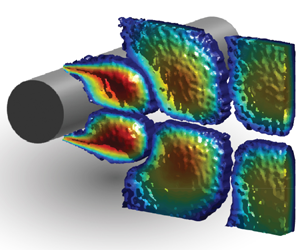Article contents
Cylinder flow and noise control by active base blowing
Published online by Cambridge University Press: 16 April 2024
Abstract

An extensive experimental investigation was undertaken to control the flow and noise characteristics influenced by vortex shedding from a circular cylinder by implementing air blowing at the base of the cylinder. The study synchronised near-field pressure and far-field noise measurements with the wake velocity field to understand the noise reduction mechanism of base blowing. Surface pressure fluctuations were measured using pressure taps distributed around the cylinder's circumference through a remote-sensing method, while velocity measurements were obtained using planar particle image velocimetry at the midspan to examine the flow dynamics. The study unveiled the crucial role of near-field pressure, particularly induced at the shoulders of the cylinder, in generating far-field noise. The rapid vertical flow movement, arising from the interaction between shear layers, was identified as a mechanism responsible for inducing surface pressure fluctuations. This phenomenon occurred as high-momentum fluid moved from the free stream into the interior of the vortex-formation region. By applying base blowing, a remarkable reduction in both near-field pressure and far-field noise was achieved at the fundamental vortex-shedding frequency, with reductions of approximately 20 and 25 dB, respectively, compared with the baseline. Additionally, base blowing caused the shear layers to roll up farther downstream than in the baseline by decreasing the entrainment of fluid-bearing opposite vorticity by the shear layer upstream of the growing vortex. Consequently, there was a substantial decrease in turbulent kinetic energy and Reynolds stress near the cylinder, resulting in slower vertical flow movement and weaker near-field pressure.
JFM classification
Information
- Type
- JFM Papers
- Information
- Copyright
- © The Author(s), 2024. Published by Cambridge University Press
References
- 12
- Cited by


